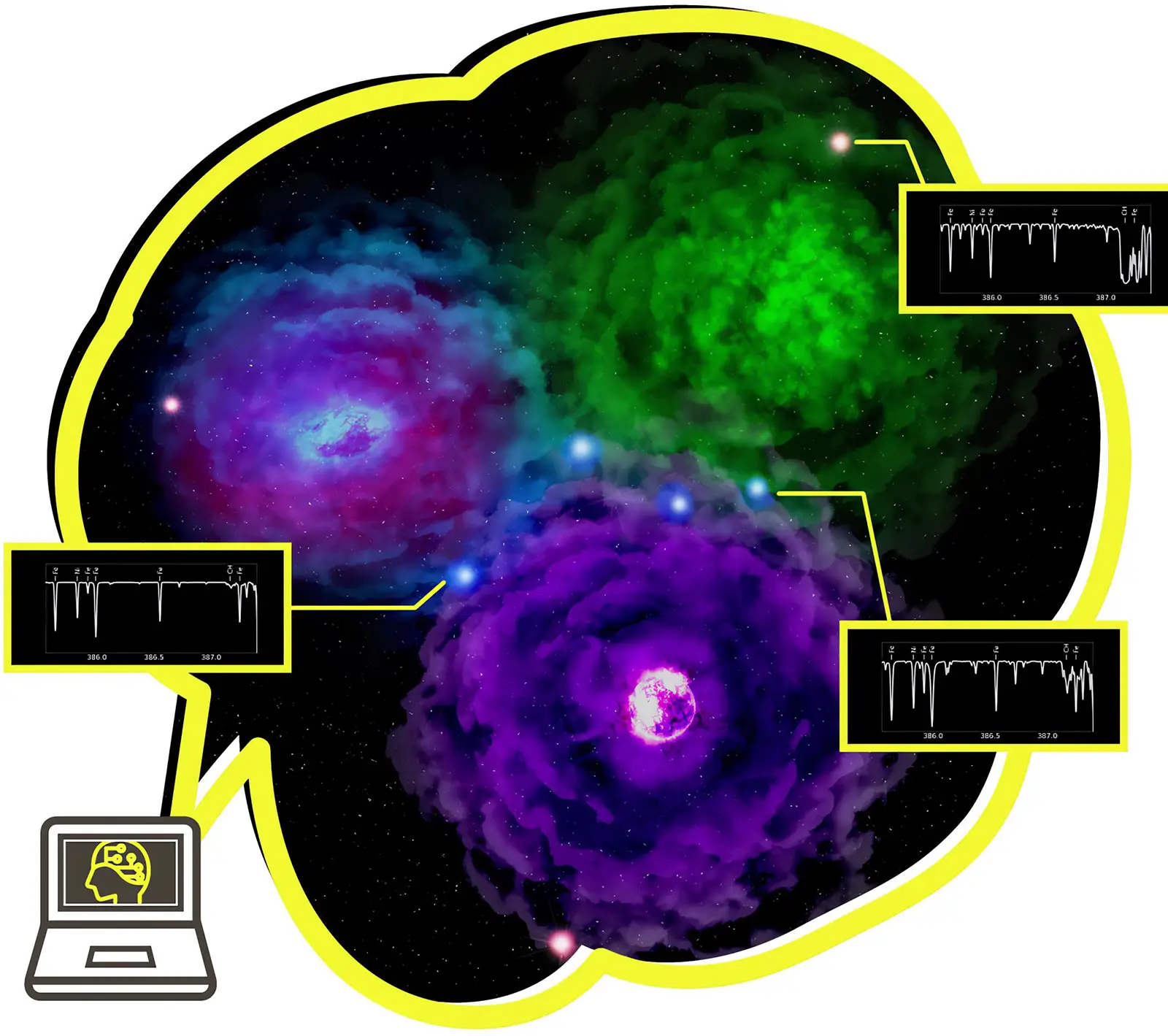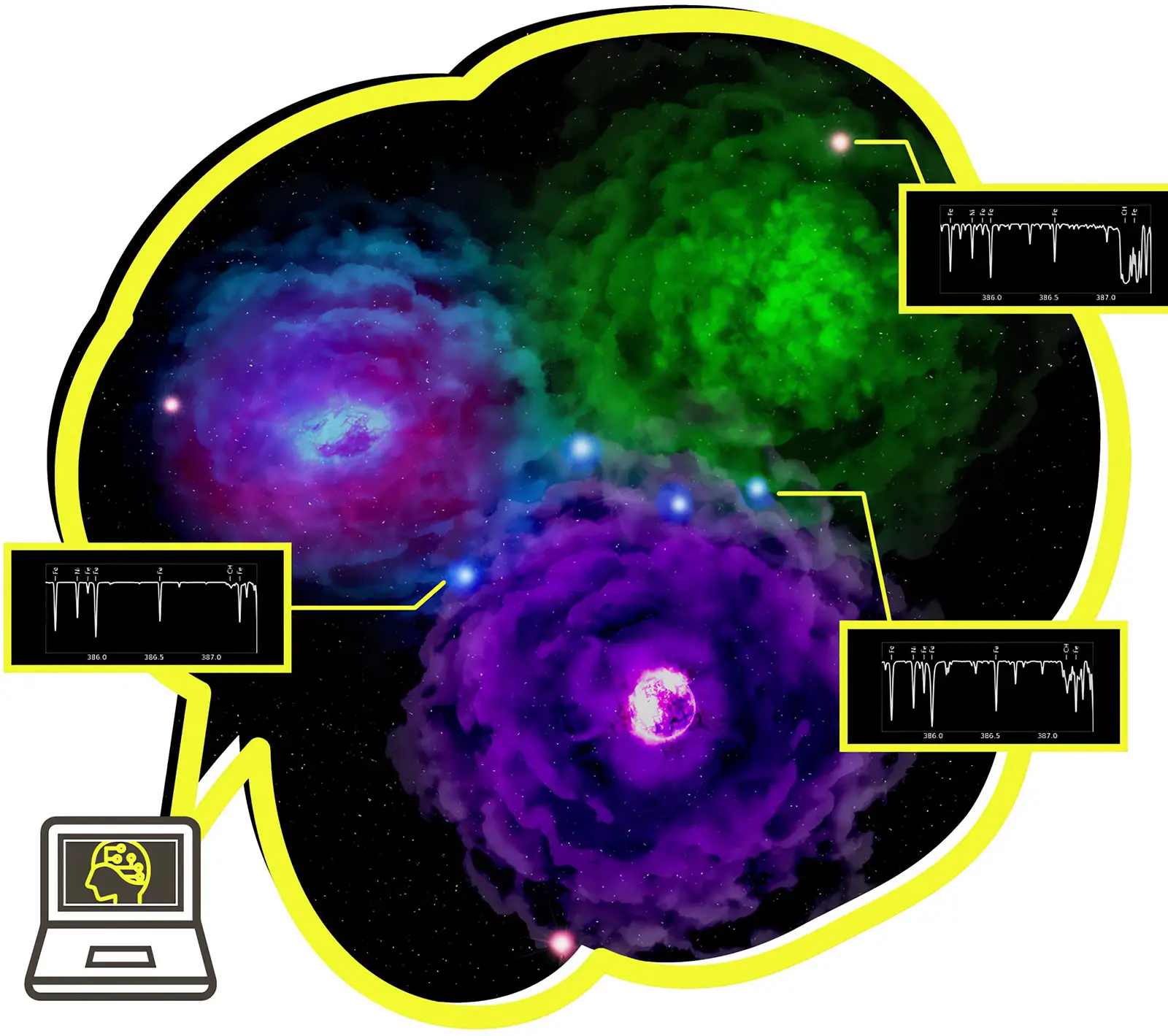
By

Figure 1. A schematic illustration of the first star’s supernovae and observed spectra of extremely metal-poor stars. Ejecta from the supernovae enrich pristine hydrogen and helium gas with heavy elements in the universe (cyan, green, and purple objects surrounded by clouds of ejected material). If the first stars are born as a multiple stellar system rather than as an isolated single star, elements ejected by the supernovae are mixed together and incorporated into the next generation of stars. The characteristic chemical abundances in such a mechanism are preserved in the atmosphere of the long-lived low-mass stars observed in our Milky Way Galaxy. The team invented the machine learning algorithm to distinguish whether the observed stars were formed out of ejecta of a single (small red stars) or multiple (small blue stars) previous supernovae, based on measured elemental abundances from the spectra of the stars. Credit: Kavli IPMU
By using machine learning and state-of-the-art supernova nucleosynthesis, a team of researchers has found the majority of observed second-generation stars in the universe were enriched by multiple supernovae, reports a new study in The Astrophysical Journal.
Nuclear astrophysics research has shown elements including and heavier than carbon in the Universe are produced in stars. But the first stars, stars born soon after the Big Bang, did not contain such heavy elements, which astronomers call ‘metals’. The next generation of stars contained only a small amount of heavy elements produced by the first stars. To understand the universe in its infancy, it requires researchers to study these metal-poor stars.
Luckily, these second-generation metal-poor stars are observed in our Milky Way Galaxy, and have been studied by a team of Affiliate Members of the Kavli Institute for the Physics and Mathematics of the Universe (Kavli IPMU) to close in on the physical properties of the first stars in the universe.

Figure 2. Carbon vs. iron abundance of extremely metal-poor (EMP) stars. The color bar shows the probability for mono-enrichment from our machine learning algorithm. Stars above the dashed lines (at [C/Fe] = 0.7) are called carbon-enhanced metal-poor (CEMP) stars and most of them are mono-enriched. Credit: Hartwig et al.
The team, led by Kavli IPMU Visiting Associate Scientist and The University of Tokyo Institute for Physics of Intelligence Assistant Professor Tilman Hartwig, including Visiting Associate Scientist and National Astronomical Observatory of Japan Assistant Professor Miho Ishigaki, Visiting Senior Scientist and University of Hertfordshire Professor Chiaki Kobayashi, Visiting Senior Scientist and National Astronomical Observatory of Japan Professor Nozomu Tominaga, and Visiting Senior Scientist and The University of Tokyo Professor Emeritus Ken’ichi Nomoto, used artificial intelligence to analyze elemental abundances in more than 450 extremely metal-poor stars observed to date. Based on the newly developed supervised machine learning algorithm trained on theoretical supernova nucleosynthesis models, they found that 68 percent of the observed extremely metal-poor stars have a chemical fingerprint consistent with enrichment by multiple previous supernovae.
The team’s results give the first quantitative constraint based on observations on the multiplicity of the first stars.

Figure 3. (from left) Visiting Senior Scientist Ken’ichi Nomoto, Visiting Associate Scientist Miho Ishigaki, Kavli IPMU Visiting Associate Scientist Tilman Hartwig, Visiting Senior Scientist Chiaki Kobayashi, and Visiting Senior Scientist Nozomu Tominaga. Credit: Kavli IPMU, Nozomu Tominaga
“Multiplicity of the first stars were only predicted from numerical simulations so far, and there was no way to observationally examine the theoretical prediction until now,” said lead author Hartwig. “Our result suggests that most first stars formed in small clusters so that multiple of their supernovae can contribute to the metal enrichment of the early interstellar medium,” he said.
“Our new algorithm provides an excellent tool to interpret the big data we will have in the next decade from ongoing and future astronomical surveys across the world,” said Kobayashi, also a Leverhulme Research Fellow.
“At the moment, the available data of old stars are the tip of the iceberg within the solar neighborhood. The Prime Focus Spectrograph, a cutting-edge multi-object spectrograph on the Subaru Telescope developed by the international collaboration led by Kavli IPMU, is the best instrument to discover ancient stars in the outer regions of the Milky Way far beyond the solar neighborhood,” said Ishigaki.
The new algorithm invented in this study opens the door to making the most of diverse chemical fingerprints in metal-poor stars discovered by the Prime Focus Spectrograph.
“The theory of the first stars tells us that the first stars should be more massive than the Sun. The natural expectation was that the first star was born in a gas cloud containing a mass a million times more than the Sun. However, our new finding strongly suggests that the first stars were not born alone, but instead formed as a part of a star cluster or a binary or multiple star system. This also means that we can expect gravitational waves from the first binary stars soon after the Big Bang, which could be detected in future missions in space or on the Moon,” said Kobayashi.
Hartwig has made the code developed in this study publicly available at https://gitlab.com/thartwig/emu-c.
Reference: “Machine Learning Detects Multiplicity of the First Stars in Stellar Archaeology Data” by Tilman Hartwig, Miho N. Ishigaki, Chiaki Kobayashi, Nozomu Tominaga and Ken’ichi Nomoto, 22 March 2023, The Astrophysical Journal.
DOI: 10.3847/1538-4357/acbcc6

